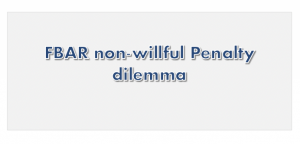On June 26, 2023 the Supreme Court granted the Petitioners’ Application for a Writ of Certiorari for purposes of considering the constitutionality of the Mandatory Repatriation Tax as it pertains to U.S. Shareholders in a Controlled Foreign Corporation.
In the instant case the Taxpayers, Charles G. Moore and Kathleen F. Moore (the “Taxpayers” or the “Moore’s”) invested approximately $40,000 in KisenKraft Machines Tools Private Limited (“KisenKraft”), a small overseas company that was formed in 2006 for purposes of empowering small scale farmers in impoverished region of India.
KisenKraft is considered to be a Controlled Foreign Corporation (CFC), which is defined in the Internal Revenue Code as a foreign corporation whose ownership or voting rights are more than 50% owned by U.S. persons (See 26 U.S.C § 957). In exchange for their investment, the Moore’s retained an 11% interest in the foreign company.
In connection with the foregoing, the Moore’s never received any income from KisenKraft, nor did they have the authority as minority shareholders to a compel a dividend payment from the foreign entity. Furthermore, the Moore’s were not in any way involved in the management of the company or its day to day affairs. It is also noteworthy that KisenKraft did not have sufficient cash for purposes of making any distribution to the Moore’s.
In 2018 the Taxpayers learned that as a result of the TCJA and the MRT provisions, they were liable for a one time transition tax in the amount of $14,729 as is related to their pro rata share of KisenKraft lifetime earnings (See 26 U.S.C. § 965).
The Moore’s paid the tax and thereafter sued for a refund in the U.S. District Court. The Taxpayers challenged the constitutionality under the MRT which permits the taxation of a CFC’s income after 1986. The Taxpayers’ claim is based upon the argument that the MRT is an unapportioned direct Tax and that the MRT violates the Constitution’s Apportionment Clause. In this regard the Moore’s argue that income must be realized before it can be taxed.
In addition the Taxpayers argue that the MRT violates the Fifth Amendment Due Process Clause since it seeks to impose a tax retroactively.
The District Court dismissed the Taxpayers’ suit and the Ninth Circuit affirmed. (See Moore v United States, 36F. 4th 930, 935 (9th Cir. 2022).
Prior to the 2017 Tax Cuts and Jobs Act (“TCJA”), U.S. taxpayers did not pay U.S. taxes on foreign earnings until those earnings were distributed to them. However, when particular categories of undistributed earnings were repatriated to the U.S. in the form of distributions, loan to U.S. shareholders or in connection with an investment in U.S. property, U.S. shareholders who owned at least 10% of a CFC could be taxed on a proportionate share of those earnings. The primary method used to tax a CFC’s U.S. shareholders on foreign earnings held offshore was a provision of the tax code called Subpart F.
The TCJA, created a new, one-time Mandatory Repatriation Tax (MRT). Under the MRT, U.S. persons owning at least 10% of a CFC are taxed on the CFC’s profits after 1986, regardless of whether the CFC distributed earnings. Additionally, going forward, a CFC’s income taxable under subpart F includes current earnings from its business.
The Ninth Circuit affirmed the Dismissal of the Moore’s complaint by the lower court. In its opinion the Ninth Circuit citing Heiner v Mellon, 304 U.S. 271, 281 (1938) held that the issue of whether a Taxpayer has realized income is not relevant to the issue of taxation. The Court also cited Eder v. Commissioner of the Internal Revenue Services, 137 F.2d. 27, 28-29 (2d Cir. 1943) a Second Circuit Decision which held that the inclusion of foreign corporate income under a statute predating Subpart F was constitutional.
The Appellate Court, in rejecting the Taxpayer’s Apportionment Claim, further held that the fact the distribution of income is prevented by operation of law, or be agreement is irrelevant to the issue of whether the income is subject to taxation.
The Ninth Circuit also rejected the Taxpayers due process challenge that the MRT violates the Due Process Clause of the Fifth Amendment. Although the Court acknowledged the presumption against retroactive laws, they duly noted, citing United States v. Carlton, 512 U.S. 26 30 (1994) that retroactive tax legislation is often constitutional. Furthermore, the Court, citing United States v. Hemme, 476 U.S. 558, 568 (1986) pointed out that ‘retroactive effect is not necessarily fatal to a revenue law.’ The Court, citing Quarty v. United States, 170 F3rd 961,965 (9th Cir. 1999), noted that for purposes of analyzing a due process challenge to retroactive tax legislation, courts use a “deferential standard of whether the retroactive application itself serves a legitimate purpose by rational means.
It is unlikely that the Supreme Court will rule in favor of the Taxpayers. Accordingly, if you are a U.S. Shareholder of a CFC, and have not declared your pro rata share of CFC earning from 1986, you could be at risk and should immediately contact and consult with an experienced and knowledgeable tax attorney.

 The Biden Tax Proposal, if enacted, will have a significant impact on estate planning for those who have failed to take advantage of the current gift and estate tax rules. According to the Proposal, estate and gift tax exemption will be reduced from 11.58 million under the current law to $3.5 million. In addition, the Biden Proposal will increase the top rate for estate tax from 40 percent to 45 percent.
The Biden Tax Proposal, if enacted, will have a significant impact on estate planning for those who have failed to take advantage of the current gift and estate tax rules. According to the Proposal, estate and gift tax exemption will be reduced from 11.58 million under the current law to $3.5 million. In addition, the Biden Proposal will increase the top rate for estate tax from 40 percent to 45 percent. A taxpayer who owes or anticipates owing a substantial amount of income tax to the IRS may be tempted to transfer his or her property to a spouse, a relative or a nominee entity with the hope of preventing the IRS from collecting the outstanding tax debt. Similarly, a taxpayer may have an incentive to transfer property to a third party, in circumstances where the taxpayer may be subject to the 26 U.S.C. § 6672(Trust Fund Penalty). The taxpayer usually justifies such a transfer as “strategic planning.” Sometimes the taxpayer acts alone. In other instances, the taxpayer may be aided by a complicit, inexperienced or incompetent attorney.
A taxpayer who owes or anticipates owing a substantial amount of income tax to the IRS may be tempted to transfer his or her property to a spouse, a relative or a nominee entity with the hope of preventing the IRS from collecting the outstanding tax debt. Similarly, a taxpayer may have an incentive to transfer property to a third party, in circumstances where the taxpayer may be subject to the 26 U.S.C. § 6672(Trust Fund Penalty). The taxpayer usually justifies such a transfer as “strategic planning.” Sometimes the taxpayer acts alone. In other instances, the taxpayer may be aided by a complicit, inexperienced or incompetent attorney. The statute of limitation for assessment purposes represents the last day in which the Internal Revenue Service may assess federal income tax. The statute of limitations for assessment should not be confused with the statute of limitations for collections. In many instances, taxpayers and their advisors rely on the general three year rule as a defense to the assessment of additional income tax without fully understanding the assessment rules. The discussion that follows will examine the general rules, the various exceptions and instances where the statute of limitations is suspended. The discussion is limited to income taxes.
The statute of limitation for assessment purposes represents the last day in which the Internal Revenue Service may assess federal income tax. The statute of limitations for assessment should not be confused with the statute of limitations for collections. In many instances, taxpayers and their advisors rely on the general three year rule as a defense to the assessment of additional income tax without fully understanding the assessment rules. The discussion that follows will examine the general rules, the various exceptions and instances where the statute of limitations is suspended. The discussion is limited to income taxes. The Courts have recently addressed the issue of whether the FBAR Non-Willful penalty should be assessed per form rather than per account with conflicting results. In
The Courts have recently addressed the issue of whether the FBAR Non-Willful penalty should be assessed per form rather than per account with conflicting results. In
